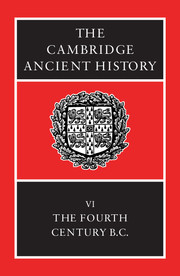Book contents
- Frontmatter
- 1 Sources and their uses
- 2 Sparta as victor
- 3 Persia
- 4 The Corinthian War
- 5 Sicily, 413–368 B.C.
- 6 The King's Peace and the Second Athenian Confederacy
- 7 Thebes in the 360s B.C.
- 8 Regional surveys I: Persian lands and neighbours
- 8a Asia Minor
- 8b Mesopotamia, 482–330 B.C.
- 8c Judah
- 8d Cyprus and Phoenicia
- 8e Egypt, 404–332 B.C.
- 9 Regional surveys II: the West and North
- 10 Society and economy
- 11 The polis and the alternatives
- 12 Greek culture and science
- 13 Dion and Timoleon
- 14 Macedon and north-west Greece
- 15 Macedonian hegemony created
- 16 Alexander the Great Part 1: The events of the reign
- 17 Alexander the Great Part 2: Greece and the conquered territories
- 18 Epilogue
- Chronological Table
- BIBLIOGRAPHY
- Index
- Map 1: Greece and Western Asia Minor
- Map 9: Egypt
- Map 20: Alexanders campaigns
- References
8d - Cyprus and Phoenicia
from 8 - Regional surveys I: Persian lands and neighbours
Published online by Cambridge University Press: 28 March 2008
- Frontmatter
- 1 Sources and their uses
- 2 Sparta as victor
- 3 Persia
- 4 The Corinthian War
- 5 Sicily, 413–368 B.C.
- 6 The King's Peace and the Second Athenian Confederacy
- 7 Thebes in the 360s B.C.
- 8 Regional surveys I: Persian lands and neighbours
- 8a Asia Minor
- 8b Mesopotamia, 482–330 B.C.
- 8c Judah
- 8d Cyprus and Phoenicia
- 8e Egypt, 404–332 B.C.
- 9 Regional surveys II: the West and North
- 10 Society and economy
- 11 The polis and the alternatives
- 12 Greek culture and science
- 13 Dion and Timoleon
- 14 Macedon and north-west Greece
- 15 Macedonian hegemony created
- 16 Alexander the Great Part 1: The events of the reign
- 17 Alexander the Great Part 2: Greece and the conquered territories
- 18 Epilogue
- Chronological Table
- BIBLIOGRAPHY
- Index
- Map 1: Greece and Western Asia Minor
- Map 9: Egypt
- Map 20: Alexanders campaigns
- References
Summary
When Cyprus and Phoenicia were incorporated into the Achaemenid empire during the later sixth century B.C. they already looked back upon long centuries of trading connexions and cultural exchanges. During the fifth and fourth centuries B.C. both areas, forming part of the Fifth Satrapy (Hdt. III.91.1), had a number of basic problems in common. Both were divided into a number of relatively small, half-independent political units. These polities were long-established monarchies: Salamis, Ceryneia, Lapethus, Soli, Marium, Tamassus, Citium, Idalium, Amathus, Curium and Paphos in Cyprus; Sidon, Tyre, Byblus and Aradus in Phoenicia.
One trend to be observed in the history of both Cyprus and Phoenicia during this period is a continuous conflict of interests between these kingdoms. Again and again local feuds arise from their attempts to extend their own territory at the cost of neighbouring states or to gain domination over the whole area. These conflicts are superseded for short periods by a common policy when the kingdoms unite in their aim to gain greater, if not absolute, independence from their Persian overlord. Such a tendency – which can be observed in all regions of the Achaemenid empire which had strong political and cultural traditions of their own – is more marked in Cyprus than in Phoenicia. The front-line position of the island during the wars between the Greek poleis and Persia more easily prompted attempts to shake off Achaemenid rule.
Cypriot kingdoms and Phoenician city states also confronted a number of similar social problems, not least the process of growing Hellenization with its consequences. Yet despite such common problems and tendencies the traditions and the development of Phoenicia and Cyprus are different to such a degree that it seems necessary to treat both areas separately during most of the period under review.
- Type
- Chapter
- Information
- The Cambridge Ancient History , pp. 297 - 336Publisher: Cambridge University PressPrint publication year: 1994
References
- 5
- Cited by

